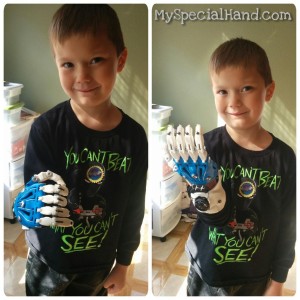I wore a prosthetic arm until my early teens.
I had a basic “mitten arm” when I was a baby and then a hook arm and then a myoelectric arm. See some sweet pictures and video of my arms in this post. They all served their purpose during the times I wore them, but then, like many of us (congenital amputees), I stopped wearing it. For me it was a combination of things. It was heavy, cumbersome, and honestly not very useful in most situations. I was never uncomfortable with my appearance, so I didn’t need one for that, either.
In fact, it’s been over 20 years since I’ve worn a prosthetic arm and while the technology I’ve seen on TV from time to time is exciting, it’s never grabbed me enough to try it for myself. That said, something else has caught my attention lately and I think it’s the future of prosthetics.
I’m talking about 3D printed prosthetics.
This blows my mind on so many levels.
In particular, I see three reasons 3D printed prosthetics are the future:
Cost. Availability. Durability.
First of all, the cost. $50. FIFTY FREAKING DOLLARS. They reference the cost of $40,000 on average for a myoelectric arm, but that’s pretty low from what I’ve seen. And if you’re talking about the i-Limb and arms like it, you’re talking into the hundreds of thousands of dollars. So, from a cost perspective alone, these hands and arms are a dream come true.
Secondly, there’s the fact that these prosthetics are available to anybody. As she says in the video above, “Anybody that can get access a three-dimensional printer can have a hand.” I’ve worked for a health insurance company for nearly a decade, so I know first-hand (so to speak) the challenges of getting them to pay for a prosthetic device. Sure, you’ll hear a good story every now and then, but for the most part parents and amputees have to fight just to get basic limbs. The problem, in my opinion, is that the people making the laws simply don’t understand how prosthetics work, especially for growing children. Covering one prosthetic device for the lifetime of the patient would be laughable if it wasn’t such a devastating circumstance.
Lastly, the durability of these devices is spectacular. Let me explain. They’re made out of hard plastic and wires and screws you can buy at a hardware store. So, if something breaks, you print the part and repair it! No visit to the prosthetist. No costly repairs to any electronic components. And you can use them anywhere! Miles O’Brien shared his first-hand experience with the high-tech, expensive arms that he’s been looking at and the limitations they have, especially when it comes to harsh conditions (Listen here). One simple example is if you encounter wet conditions. The high-tech arms are highly susceptible to water damage, whereas the 3D printed devices are not.
None of this is very good news, I assume, for companies that produce and sell high-end electronic prosthetic devices. And please don’t hear me saying that there isn’t a place for them. There is. I’m simply saying that the 3D devices provide an option for the many millions who don’t have access to the high-end devices. I can’t say enough about the folks involved with e-NABLE and their efforts in this endeavor!
So, are the 3D printed devices as aesthetically pleasing? Depends on your taste. Are they as advanced? Not really. But, due to their cost, availability and durability, I believe they are the future of prosthetic devices. And I firmly believe, due to the open nature of their creation, that the quality of these devices will continue to improve.
And ultimately, when I see my friends affected positively – like Sam, pictured below – I know we’re onto something good.
What do you think? Have you had experience with either of these options? Share it below!






















This is interesting technology, but I am suspicious of it getting (oh boy, I’m going to regret this) out of hand. See, the issue is it is hard enough getting funding for purchasing prosthetics, let alone funding for developing prosthetics without the insurance companies being able to say, “here’s fifty bucks, go get a grip.” The market for hands is so small compared to legs, and the complexity is so much higher too. This is a bad economic combination. So, wouldn’t it be great if we could just print our way out of it? Sure. Do you have a 3D printer? Neither do I. Even if I did, I would tire of having the first thing I did on a Monday be print out a couple of digits to fix the ones I broke yesterday. Thanks, but I’d rather have a BeBionic or an iLimb (which by the way no longer costs hundreds of thousands of dollars — not even in Canada). But,it doesn’t really matter what I think. The genie is out of the bottle. I have a feeling though that not much will come from this incarnation of the rapid prototyped hand (for that is the original intent of 3D printers … rapid prototyping), just like not much has come of the 3D printed gun (another unfortunate idea … actually a more of an unfortunate idea than the hand, by like a billion). The wow factor is high, but the long-term factor is going to be a bit zzzzzzzz.
This screed, by the way, was typed half by a real hand, and half by an Otto Bock Sensor Speed hand that is on it’s last legs. I’m a congenital non-right-hand-having guy. My stump has a very tiny hand on it that when I was a kid often served as a nose when I would mark up my stump as an arm puppet. I was a weird kid. At times I’m still a weird adult.
I think there is a place for both. As a life long prosthetic user I’ve always felt an obligation to be an early adapter/ guinea pig for new technology because the number of upper extremity prosthetic users is so small. I have accumulated quite the collection of arms/hands through the years, each serving a specific purpose. They all have pluses and minuses and there are things I find easiest to do without an arm on. I’ve had my current myo for 10+ years and can’t remember the last time it was serviced. Needless to say, it doesn’t accompany me on mud runs. Growing up I would probably have preferred a Robohand to the hook. As an adult I’m sure I would find a use for a 3D printed hand like the one pictured, or for a printed activity specific terminal device that could be attached to one of my arms. For me it comes down to access and options- the more the better!
I commend the folks at e-nable for what they are doing. When I first discovered their website earlier this year I was amazed at what they are able to accomplish. The prosthetic hands are a combination of low-tech simplicity with the new 3D printing technology. Watching their video got the wheels turning in my own mind. For me the issue is a comfortable socket interface. I have a short limb below the elbow so there isn’t so much for the prosthesis to hang on to. I am in discussions with my prosthetist and a biomedical engineer and we are exploring what might be done. There is even some discussion about turning this project into a funded research project. What I want is a comfortable socket first and foremost. Human skin tissue expands and contracts on a daily basis but a silicon molded socket does not. My near term goal is to have a 3D scan of my limb and then experiment with some socket designs from there.
This sounds awesome, Rick! Thanks for sharing!
First of all I must admit I am on the outside looking in. I am blessed with all my fingers and toes working. I am also blessed with a creative mind and a 3d printer. I recently learned about Enable will likely help with there mission. I also learned about this web site through them .
You understand the struggles of of limb deficiencies I do not. I do however have a decent grasp of engineering technology and 3D printing.
1) the 3-D printed prosthetic as Ryan pointed out is for the undeserved those who can not afford or access the high end prognostics.
2) e-nable is not expecting everyone that needs a hand to buy a printer the whole point of the organization is to pair volunteers with technical skills and a 3D printer to help those who need a hand//prosthetic. .
3) While 3-D printers were first intended for rapid prototyping the new materials allow for structurally sound parts to be made.
4) the $50 hand is only possible though the generous donation of time from volunteers. this figure just covers material costs. the same hand made in a doctors office or prothetists office will likely cost several hundred dollars.
5) machine time to print a hand is something like 12 -16 hours to make all the parts. Plus time to measure the user assemble the hand and fit and adjust to the user so another 1.5 to 3 hours.
6) Rick sounds like you are in a great position to help and advise on the socket Ideas.
7) Ryan Hope to meet you at the conference . and kudos for helping kids cope IMHO tough for kids to grow up with good support and self esteem these days and having a limb deficiency can make things even tougher. I plan on being at the JH conference and am car pooling with a couple of engineers that work for medical device companies, should be interesting.
I expect to learn more about this technology and hope to be able to help e-nable in the future.
Unlike the other comments, I don’t have anything insightful to add. But I do know that there’s 2 3D printers at the local Catholic School which pretty much no one knows about, and a young bloke I work with has access to them.
See where this is going? 🙂 I don’t think I’ll use it a lot, but it’ll be a right interesting experience!
I just reread my optimistic post from September 5, 2014. Unfortunately, I can only report that my hope of a comfortable 3D printed socket hasn’t moved forward…at least not yet. I live in the Chicago area and I have access to a lot of smart people but the idea just ain’t going anywhere. There is this institutional tendency to revert to the already known and proven (..and profitable). My idea for an improved socket would be a mesh design (I got this idea from a cell phone case I saw.) Only a 3D printer could create a mesh socket with a hundred little holes. The mesh would allow for air flow as well as the expansion and contraction of skin tissue. Those of us who use a prosthetic know what it is like to wear an arm on a hot humid day. Also, human skin isn’t the same from one hour to the next…temperature, humidity, water and sodium intake can all contribute to changes in how a socket fits. A mesh designed socket would be more forgiving.